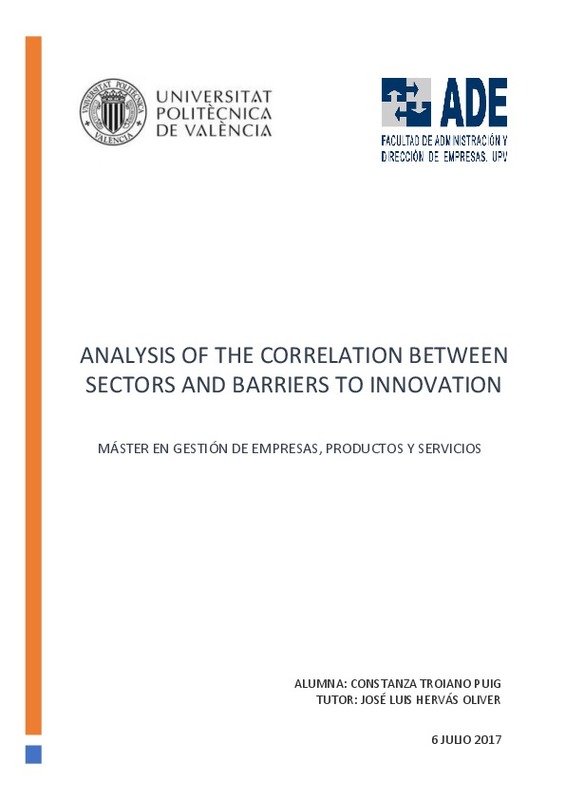JavaScript is disabled for your browser. Some features of this site may not work without it.
Buscar en RiuNet
Listar
Mi cuenta
Estadísticas
Ayuda RiuNet
Admin. UPV
Analysis of the correlation between sectors and barriers to innovation
Mostrar el registro sencillo del ítem
Ficheros en el ítem
| dc.contributor.advisor | Hervás Oliver, Jose Luis
|
es_ES |
| dc.contributor.author | Troiano Puig, Constanza
|
es_ES |
| dc.date.accessioned | 2017-09-06T14:37:02Z | |
| dc.date.available | 2017-09-06T14:37:02Z | |
| dc.date.created | 2017-07-24 | |
| dc.date.issued | 2017-09-06 | es_ES |
| dc.identifier.uri | http://hdl.handle.net/10251/86561 | |
| dc.description.abstract | [EN] Innovation is becoming more popular in the last years and as a consequence, the population starts to be more aware about its effect. Innovation is surrounding us, is the future, something that add value, something that allow companies to be more competitive. Every time, more firms are interested on performing innovation activities in order to achieve some of their objectives such as increase turnover, reduce costs, increase their performance, etc. This concept, is also associated to economic growth, business survival, employment growth, social welfare and competitiveness. Thus, innovation is essential in this world in constant change and improvement. Because of that, it is unavoidable to find research that deal with this topic. Analyze innovation and its effect over companies is crucial to understand better this phenomenon which is taking more relevance. However, it has been observed that there exist some constraints that hamper innovation. As this last topic is not widely studied by economic sectors, this research is focus on determine barriers’ impact over Spanish firms while an evaluation of innovation activities is performed. Findings about which are those sectors who innovate more and which are the ones who must deal with a larger number of barriers is provided at the end of this project. | es_ES |
| dc.description.abstract | [ES] En este trabajo se identificarán cuáles son los sectores definidos por el CNAE que presentan más barreras a la innovación y, por lo tanto, son menos innovadores. También se estudiará la relación presente entre ambas premisas y se corroborará que ambas variables son directamente proporcionales. Mediante el análisis de datos proporcionados por diversas fuentes como Eurostat, será posible determinar cuáles son las barreras actuales a las que estos sectores se tienen que enfrentar y cuál es el grado de impacto. Por lo tanto, se utilizarán diversas herramientas para la investigación como, por ejemplo, la técnica multivariante cluster con el fin de comparar la interacción entre los distintos sectores con las barreras analizadas. | es_ES |
| dc.format.extent | 65 | es_ES |
| dc.language | Inglés | es_ES |
| dc.publisher | Universitat Politècnica de València | es_ES |
| dc.rights | Reserva de todos los derechos | es_ES |
| dc.subject | Eurostat | es_ES |
| dc.subject | Obstáculos a la innovación | es_ES |
| dc.subject | Innovación | es_ES |
| dc.subject | Clasificación Nacional de Actividades Económicas (CNAE) | es_ES |
| dc.subject.classification | ORGANIZACION DE EMPRESAS | es_ES |
| dc.subject.other | Máster Universitario en Gestión de Empresas, Productos y Servicios-Màster Universitari en Gestió D'Empreses, Productes i Serveis | es_ES |
| dc.title | Analysis of the correlation between sectors and barriers to innovation | es_ES |
| dc.title.alternative | Análisis de la correlación entre sectores y barreras a la innovación | es_ES |
| dc.type | Tesis de máster | es_ES |
| dc.rights.accessRights | Abierto | es_ES |
| dc.contributor.affiliation | Universitat Politècnica de València. Facultad de Administración y Dirección de Empresas - Facultat d'Administració i Direcció d'Empreses | es_ES |
| dc.contributor.affiliation | Universitat Politècnica de València. Departamento de Organización de Empresas - Departament d'Organització d'Empreses | es_ES |
| dc.description.bibliographicCitation | Troiano Puig, C. (2017). ANÁLISIS DE LA CORRELACIÓN ENTRE SECTORES Y BARRERAS A LA INNOVACIÓN. http://hdl.handle.net/10251/86561. | es_ES |
| dc.description.accrualMethod | TFGM | es_ES |
| dc.relation.pasarela | TFGM\68291 | es_ES |
Este ítem aparece en la(s) siguiente(s) colección(ones)
-
ADE - Trabajos académicos [3699]
Facultad de Administración y Dirección de Empresas






